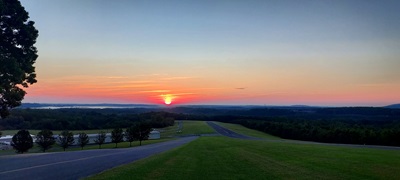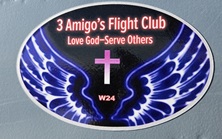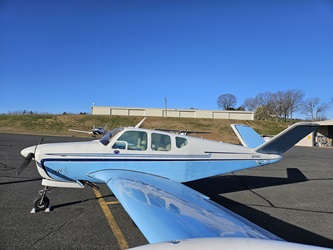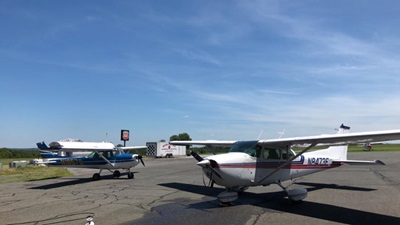To ensure a club remains viable requires understanding the club’s mission, the type of flying the members want to do, and the budget constraints of the club. The 3 Amigos Flight Club based at Falwell Airport (W24) in Lynchburg, VA aims to provide good GA aircraft at a reasonable price. 
The club has about 25 to 30 members and a fleet that consists of a Cessna 150 and three Cessna 172s. Several years ago, it also added a 1955 V-tail Bonanza and quickly found the aircraft wasn’t well suited for a club environment.
The club was formed about 10 years ago by Roger Beck after he took over operations at Falwell Airport. The privately-owned, public use airport known for its downhill, “ski-jump” like runway wasn’t very active in those days. At the time he had a 1947 Bonanza and a Cessna 172. Roger had been buying 172s, cleaning them up and reselling them. But when the economy took a nosedive in 2008, the used aircraft market dried up, so he hung on to the one he had. To offset the costs of insurance and maintenance he decided to form a club, and the 3 Amigos was born.
Aviation and flying clubs are part of Roger’s DNA. “My family has been in aviation from the First World War forward. My grandfather was a mechanic on Curtiss flying boats,” Roger said. “My father was a pilot in the Second World War, flying fighters, bombers and the PBY-5A Catalina. My oldest brother was a RIO on F-4s and F-14s during the Vietnam era and after that. The whole family had a passion for aviation.”
After WWII, his father moved back to Troy, New York, got married and was going to Rensselaer Polytechnic Institute. While at school he started the Rensselaer Polytechnical Institute Flying Club, which is still in operation today. As he moved around for work, Roger’s father started a few other flying clubs.
Given his family history, it was only natural that Roger would form a flying club with his 172. “I wanted people to fly it and to bless somebody else with the resources the Lord has given me,” he said. “So, we got some people together and formed the 3 Amigos Flight Club.”
In 2017, Roger acquired a 1955 F35 Bonanza and added it to the 3 Amigos Fleet. The plane attracted pilots to the club with a higher experience level and certifications such as complex and high-performance endorsements. But it wasn’t a good fit. “I found it was a little bit too complex for some of the pilots that were already in the club,” Roger said.
The main challenge was the Beech 215 electric prop that was used for the first 9 years of production. Most constant speed props are hydraulically driven by engine oil pressure using a governor. The pitch of the Beech 215 prop is changed using an electric motor linked to the yoke through a series of bolts, bearings, and gears. “It can be manually controlled by the pilot, or it can be electronically governed for certain engine speed,” Roger said. “It is a different animal to fly, and you’ve got to know how to fly it.”
What Roger found was that many of the pilots unintentionally abused the prop. After about six months in the club, he had to pull the plane out for repairs. “It cost me almost as much [to make repairs] as what the aircraft cost me initially. So that plane did not go back in the club,” Roger said.
Part of the reason for the expensive repair is that the parts needed have not been made for more than 50 years and are scarce. Not only was it a costly repair, but it took quite a long time because of the difficulty in finding good usable parts. Beginning in the late 1950s, Beech replaced the electric prop with a hydraulic prop. There also is an STC to retrofit the early Bonanzas, which has been done to many of them.
Besides the electric prop, flying a V-tail Bonanza is a little different. The combined rudder and elevator, called a “ruddervator,” gives the plane its distinctive tail and all the controls are interconnected – the ruddervator and the ailerons. Roger said the plane will yaw in turbulence a little. “It may be unnerving, but the darn thing is not going to turn itself around. It's not going to become uncontrollable.”
In fact, Roger said he usually flies with his feet off the rudder pedals in smooth air. If he hits a little turbulence and the plane yaws a bit, he puts his feet on the rudder pedals and the yaw tends to go away.
Another aspect of the V-tail Bonanza that clubs should keep in mind is that it’s a very fast airplane. “You need to think ahead of it by a couple of minutes or else it will turn around and bite you simply because it is that fast. It's slippery,” Roger said. He also noted that because he’s got a lot of hours in V-tail Bonanzas, he knows what to expect.
Given the flight characteristics, Roger’s insurance policy requires a pilot to have an IFR rating, a minimum of 700 hours, and 10 hours make and model, to fly the plane. “For somebody who knows how to fly these planes, they're wonderful,” Roger said. “They are absolutely wonderful airplanes.”
That said, the early model V-tail Bonanza that the 3 Amigos had in the club just wasn’t a good fit. The nuance of using the electric prop, and the time and expense to repair it, if necessary, made the plane unfeasible in a club environment. So, the club decided to stay with the ubiquitous Cessna 172 and 150. Both planes are easy to fly, and the cost to operate a 172 is reasonable. Maintenance shops are familiar with 172s, and parts are plentiful.
“As far as taking a look at the viability of what aircraft to use in a club environment, you really can't beat a 172,” Roger said. “The parts are out there, and they are fairly easy to work on. They are the generic airplane.”
At the end of the day, Roger was focused on fulfilling the club’s mission to provide quality aircraft at a reasonable price, which the 172 does. By keeping costs low, the 3 Amigos is able to “bring joy to a lot of different people,” using an aircraft that most pilots are familiar with and is economical to operate.
For more information on general club viability, take a look at the March 2023 Question of the Month as well as these earlier articles:
https://youcanfly.aopa.org/flying-clubs/flying-club-newsletter/2021/may/16/question-of-the-month
Factsheet
|
Name |
3 Amigos Flight Club |
|
Location |
Falwell Airport (W24) Lynchburg, VA |
|
Website |
|
|
|
|
|
Contact |
|
|
Year formed |
2013 |
|
Aircraft |
1973 C-150L ($55/hr maintenance fee) 1967 C-172H ($75/hr maintenance fee) 1977 C-172N ($75/hr maintenance fee) 1979 C-172N ($75/hr maintenance fee)
Rates are Tach time, dry. |
|
Joining fee |
$40 application fee |
|
Monthly dues |
$125 per month |
|
Membership |
25 to 30 |
|
Scheduler |